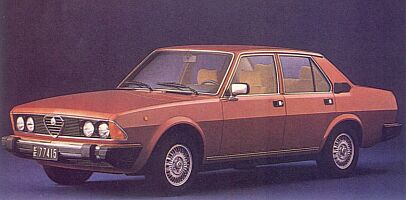 In April 1979 Alfa Romeo introduced their new flagship model, the Alfa 6. The four-door,
three-box body used a similar style to the existing Alfetta
model, although the considerably larger boot and bonnet made it a much
more imposing vehicle. The drag coefficient was a respectable 0.41.The
engine was an all new V6 with a capacity of 2492cc, which generated 158bhp
at 5,600rpm using a total of six carburettors and a single, belt driven
camshaft in each cylinder head. The drivetrain was conventional, with the
engine and gearbox at the front and a limited slip differential at the
rear. The suspension was similar to the Alfetta, with a de Dion system
at the rear and independent front corners, but the gearbox was located
in a more conventional position, aft of the engine (rather than at the
rear like the Alfetta). A three speed automatic transmission from ZF was
available as an option, whilst a hydraulic power steering unit, also from ZF, was the first to be fitted to an Alfa Romeo.
In April 1979 Alfa Romeo introduced their new flagship model, the Alfa 6. The four-door,
three-box body used a similar style to the existing Alfetta
model, although the considerably larger boot and bonnet made it a much
more imposing vehicle. The drag coefficient was a respectable 0.41.The
engine was an all new V6 with a capacity of 2492cc, which generated 158bhp
at 5,600rpm using a total of six carburettors and a single, belt driven
camshaft in each cylinder head. The drivetrain was conventional, with the
engine and gearbox at the front and a limited slip differential at the
rear. The suspension was similar to the Alfetta, with a de Dion system
at the rear and independent front corners, but the gearbox was located
in a more conventional position, aft of the engine (rather than at the
rear like the Alfetta). A three speed automatic transmission from ZF was
available as an option, whilst a hydraulic power steering unit, also from ZF, was the first to be fitted to an Alfa Romeo.
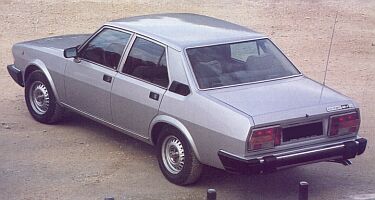 In 1983 the second series was launched. A minor (no changes to the metalwork),
but noticeable facelift was conducted, with single square headlights replacing
the twin round units, new bumpers, the addition plastic rubbing strips
along the flanks, a new grille and new trim around the rear lights. Internally
minor detail and trim changes were executed, whilst mechanically the engine
received Bosch L-Jetronic fuel injection to replace the six carburettors,
the power remaining at 158bhp.
In 1983 the second series was launched. A minor (no changes to the metalwork),
but noticeable facelift was conducted, with single square headlights replacing
the twin round units, new bumpers, the addition plastic rubbing strips
along the flanks, a new grille and new trim around the rear lights. Internally
minor detail and trim changes were executed, whilst mechanically the engine
received Bosch L-Jetronic fuel injection to replace the six carburettors,
the power remaining at 158bhp.
For tax reasons, a 1997cc version (135bhp, still with carburettors) of the 2.5 V6 engine was introduced, and at the same time a 2494cc 5-cylinder (105bhp) turbodiesel engine (by VM) was also offered.
See also our Alfa Romeo Concept Cars page for pictures of the pretty 1983 Delfino Alfa 6 based coupe.
Total production (which stopped in 1987) was as follows :
first series :
2.5 V6 : 6,385
second series :
2.5 V6 : 1,168
2.0 V6 : 1,771
turbodiesel : 2,746
total : 12,070
Technical Details
| Driveline | longitudinal engine at front with rear wheel drive |
| Engine | 2492cc (88x66.3mm) V6 with 158bhp @ 5,600rpm
1997cc (80x66.2mm) V6 with 135bhp @ 5,600rpm 2494cc (88x82mm) in-line 5 cylinder turbocharged diesel with 105bhp @ 4,300rpm |
| Suspension | front : wishbone with telescopic dampers and torsion bars
rear : de Dion axle with telescopic dampers and coil springs wheelbase : 2600mm track (front/rear) : 1408mm/1365mm |
| Brakes | front : discs, ventilated
rear : discs, mounted inboard handbrake operating on the rear via cable dual hydraulic circuit with servo assistance |
| Gearbox | 5 speed manual
hydraulic clutch 3 speed automatic |
| Steering | Rack and pinion with power assistance |
| Kerb weight | 2.0 & 2.5 : 1470kg
2.4 TD : 1580kg |
Click
here for a cutaway picture of an Alfa 6
Performance
| model | max speed | standing km |
| 2.5 V6 (1979) | 195 km/h | 30.3 sec |
Tuning
1. The engine.
Before modifying the engine it is worthwhile filling it with a good quality synthetic oil and fitting new spark plugs. An engine oil additive may also be used.
The first improvements are relatively simple.
The air filter can be replaced for an aftermarket item which will help
the engine breathe more freely, the type which completely replace the original
unit are best, and the exhaust can be replaced for one which will restrict
the exit of the gases less. The complete system should be replaced, not
just the rear section.
There are two options for increasing the
power of the engine, through bigger jets and chokes, or by using the injection
system from the GTV6 with an aftermarket module. It is possible to use
the 164 camshafts which will provide a good hike
in power whilst retaining excellent driveability. The ultimate option is
to fit a 3.0 litre unit.
Further modifications require the machining
of the cylinder headand/or cylinder block (which will not be dealt with
here since it is not normally a DIY job) after which it may be worth fitting
an oil cooler. If overheating is a problem due to the increased power output
then a small hole can also be drilled through the plate in the thermostat.
Regarding the transmission the main requirement
is to uprate the clutch to handle the increase in power and torque achieved
though the engine modifications. Friction plates can be purchased with
improved materials and heavier duty pressure plates are also available.
Whilst doing this it is worthwhile lightening the flywheel.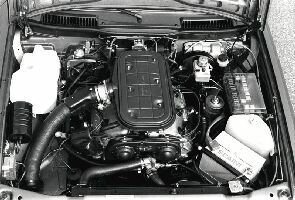 Other
things to do should include fitting a cold air intake, a large diameter
pipe (minimum 5cm) to provide air from outside the engine bay to the air
filter. The exhaust manifold(s) can also be lagged with thermal cloth or
tape to keep the exhaust gases hotter (and thus reduce back pressure) and
also to keep the underbonnet (and hence intake and fuel) temperatures lower.
Other
things to do should include fitting a cold air intake, a large diameter
pipe (minimum 5cm) to provide air from outside the engine bay to the air
filter. The exhaust manifold(s) can also be lagged with thermal cloth or
tape to keep the exhaust gases hotter (and thus reduce back pressure) and
also to keep the underbonnet (and hence intake and fuel) temperatures lower.
The high tension leads can also be replaced with performance ones.
2. The brakes.
If more serious braking is required the
next modification would be to increase the disc size. It is possible to
use larger discs with a bracket allowing use of the production callipers,
or alloy four pot callipers can be fitted.
In order to improve the balance of the
car under braking it is desireable to be able to adjust the balance of
braking from front to rear (and vice versa). This can be accomplished by
fitting a bias valve in the line to the rear brakes, usually in a position
so that it can be reached from the drivers seat. Initially
it is relatively easy to replace the brake discs with drilled and grooved
items, and the pads for a harder compound. The latter should not be too
hard (ie no race pads on the road) or they will not function effectively
at the normal 'road' operating temperatures. Stainless steel braided flexible
hoses will improve the pedal feel and reduce the chance of damage whilst
DoT5 fluid (not silicon) will increase the temperature at which it can
operate effectively. If the brakes are getting too hot the dustguards can
be removed and/or ducts fitted, taking air from behind the front bumper.
Initially
it is relatively easy to replace the brake discs with drilled and grooved
items, and the pads for a harder compound. The latter should not be too
hard (ie no race pads on the road) or they will not function effectively
at the normal 'road' operating temperatures. Stainless steel braided flexible
hoses will improve the pedal feel and reduce the chance of damage whilst
DoT5 fluid (not silicon) will increase the temperature at which it can
operate effectively. If the brakes are getting too hot the dustguards can
be removed and/or ducts fitted, taking air from behind the front bumper.
3. The suspension.
The easiest improvement,and the one which
will probably bring the single most noticeable change, is to lower and
stiffen the There are then two other main suspension
aims; to reduce the flexiblity in the suspension and to increase the stiffness
of the car, both of which aim at more accurate control of the wheel movement.
To reduce the flexibility it is possible to fit nylon bushes instead of
the normal production rubber items, or if perfection is desired the suspension
can be fitted with metallic bearings (rose joints / rod ends). Spherical
bearing top mounts can also be used. To stiffen the car it is most popular
to fit strut braces. These can be fitted to the front and rear. For more
extreme cases a rollcage can be fitted.....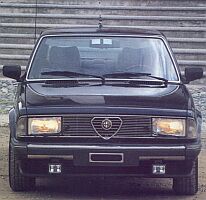 suspension.
The car can be lowered about 50mm by fitting shorter springs at the rear
(around 140lbs/in) and adjusting the torsion bars at the front. Top adjustable
dampers are compromised, but are good for road and track day cars since
it allows the suspension to be adjusted between these two, rather different,
requirements. The anti-roll bars can also be replaced with thicker items.
suspension.
The car can be lowered about 50mm by fitting shorter springs at the rear
(around 140lbs/in) and adjusting the torsion bars at the front. Top adjustable
dampers are compromised, but are good for road and track day cars since
it allows the suspension to be adjusted between these two, rather different,
requirements. The anti-roll bars can also be replaced with thicker items.
Into this category also fall the choice of wheels and tyres. With an increase in power it can be necessary to fit larger tyres (thus requiring larger wheels) but the temptation to fit the biggest possible should be resisted. Consideration should be given to fitting a wider tyre on the rear (since they provide traction) but keeping the standard, or a wider but not as wide as the rear, tyre at the front. This will improve the balance of the car and not make the steering too heavy.
4. other things.
Other modifications worth considering include fitment of a shift light (and rev limiter if there is not one as standard), higher power bulbs in the headlights (if you are going to go faster you need to see further) and installation of a quicker steering rack.
Identification
| Model No. | Details | Engine No. | variants |
| 119A | 2492cc V6, manual, from 1979 | AR01913 | |
| 119A1 | 2492cc V6, automatic, from 1979 | AR01913 | |
| 119.32 | 1997cc V6, from 1983 | AR01932 | |
| 119.28 | 2492cc V6 injection, manual, from 1983 | AR01928 | 119.29 rhd |
| 119.30 | 2492cc V6 injection, automatic, from 1983 | AR01928 | 119.31 rhd |
| 119.20 | 2494cc 5cyl turbodiesel, from 1983 | 5HT/2.5 |
Maintenance
The most common problem with the 6 is the
hydraulic cambelt tensioner. This should be checked by removing the left
timing belt cover, especially if there is any oil under the front of the
car !. It can be replaced with a 164 unit which preforms better and lasts longer.
We always recommend the use of original parts where available.
The front brakes are also prone to problems
- they should be regularly checked and cleaned to prevent seizure. Preventative
maintenance is worthwhile here.
Buying / Selling
Some tips to do before selling :
(they may seem obvious, but most people don't do them and thus are in a
weaker bargaining position)
Tidy inside the car thoroughly : hoover
the floor, empty all pockets, ashtrays (wash), glove compartment etc...,
wipe the trim with a damp cloth, give the cockpit a good airing to get
rid of any odours ! Reset the trip meter to 00000 - it is a pleasant (subconcious)
If the car has been standing give it a
good run - this will clear out the engine (reduce exhaust smoke), put a
shine on the brake discs and loosen up any joints that may otherwise make some noises.
'Back to black' products are very effective
at temporarily restoring bumpers and trim. This makes a big difference
to any car. Do it a week before you expect people to view the car, otherwise
it may be a bit too obvious !
Jetwash under the car, especially under
the engine and in the wheelarches. The prospective buyer may be an enthusiast,
and this makes it easier for them to see what they want to check.
Obviously wash the car and clean the windows !
If you are going to buy a car always check the following :
To start with, check the bodywork. Pay
special attention to the wheelarches (inside if there is no plastic splash
guard), suspension and engine mounts, sill, door pillars (check for sagging
doors), scuttle panel and the floor (doors, bonnet and boot/hatch are also
susceptible, but are more easily replaced). If a sunroof is fitted check
around the edge for signs of rust.
Check for a damp carpet or the presence
of mould - if the carpet is damp then the floor is almost certainly corroded.
Check the main electrical functions - wipers, windows, etc... try putting the
main beam and wipers on at the same time. Check the headlight reflectors for rust.
Check for excessve wear in the rear suspension bushes.
Check the brake pedal does not go to the
floor if pressed hard for a long time and check the gearchange for clean engagement.
Check tyre wear, uneven patterns could imply a bent chassis.
Always take it for a test drive. Check
that the car tracks in a straight line with no steering input and remains
in a straight line under braking. Find a large open area and complete several
lock to lock turns (also in reverse), listening for any noises. Try the
handbrake when moving - seized rear callipers will mean uneven braking or no braking. surprise.
surprise.
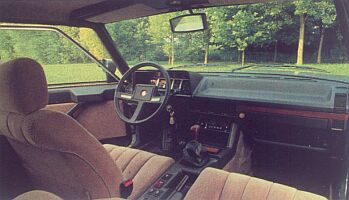 Check that there are no mismatching panels,
large areas of discolouration or signs of fresh paint. Compare the paint
colour in the engine bay with that of the exterior.
Check that there are no mismatching panels,
large areas of discolouration or signs of fresh paint. Compare the paint
colour in the engine bay with that of the exterior.
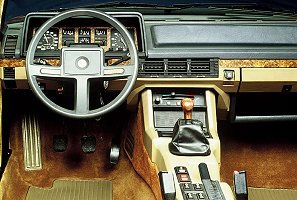 The engine should be run up to temperature,
check the exhaust for smoke, the condition of the breather (look for mayonnaise),
the condition of the oil filler cap (again white deposits can indicate head
gasket or other serious problems) and the colour of the coolant (preferably
not brown!). If the car has an oil pressure guage this should not drop
below 1 bar at idle, and should be around 3 to 4 bar at speed. Listen to
the noise of the engine, then depress the clutch and engage first gear.
Whatever noise has disappeared was coming form the gearbox, what remains
is from the engine. Check the colour of the oil using the dipstick. A golden-brown
is best, darker brown is ok, but thick and black should be avoided.
The engine should be run up to temperature,
check the exhaust for smoke, the condition of the breather (look for mayonnaise),
the condition of the oil filler cap (again white deposits can indicate head
gasket or other serious problems) and the colour of the coolant (preferably
not brown!). If the car has an oil pressure guage this should not drop
below 1 bar at idle, and should be around 3 to 4 bar at speed. Listen to
the noise of the engine, then depress the clutch and engage first gear.
Whatever noise has disappeared was coming form the gearbox, what remains
is from the engine. Check the colour of the oil using the dipstick. A golden-brown
is best, darker brown is ok, but thick and black should be avoided.
Links
A private Alfa 6 website.
An Alfa 6 register website.
There is also a list of all our picture galleries (including museums, motorshows and various events).
Wallpapers/Desktop Backgrounds of numerous Alfa Romeo's also available to download.
There are also various statistics regarding production and sales.![]() For books on Alfa Romeo see our Online Bookstore
For books on Alfa Romeo see our Online Bookstore
Alfa 6 comment form
Your Comments
My name is Norul. I am writing this comment in Malaysia. I have a 1984 2.5L automatic 6carbs Alfa 6. The car is a lot better than 1984 1.8L Honda Accord which I owned before. This is why I replace my Honda Accord with Alfa 6 last month.
Copyright © 2000 to 2008 CarsfromItaly Use
the buttons at the top to navigate further, or
Use
the buttons at the top to navigate further, or